« Return to FMDAA entries

Orange County (Fla.)
Overview
Orange County, with a population of 1.3 million people, is recognized as the number one tourist destination in the United States. Over 72 million tourists visit Central Florida attractions, resorts, and convention centers every year, which are predominantly located in Orange County. Orange County government (OCG) has over 400 buildings comprised of 5.4 million square feet, which serve the citizens and visitors of the county. Orange County Facilities Management (OCFM) is responsible for the operations and maintenance of all the facilities. Under the leadership of Richard F. Steiger, Jr., FMA, the division is comprised of overseeing contract management, capital projects, energy conservation and sustainability, maintenance operations, worksite services, training and development, warehouse operations, and mail distribution. OCFM currently has six maintenance districts with over 160 skilled employees.
The attractiveness of Orange County for both tourists and residents is derived from the climate and environment. As a division of Orange County government, facilities management believes it is our responsibility to defend and bolster these aspects that give our region its world-renowned appeal. Therefore, we undertook the challenge to make subtle, yet impactful changes to occupied spaces in order to reduce each building’s environmental impact and alter the habits of its occupants to increase sustainability around the county.
There were two motivators behind altering the way the division operated — environmental and financial. Located in a state that thrives off ecotourism, OCFM knows how critical the environment is to the local economy. The environment plays a major role in drawing visitors to the sunshine state. Orange County’s location is the headwaters of the Everglades and puts the community in a key position in the conservation and protection of the state’s ecosystem. Financially, in the years following the last recession, the division faced tighter budgets while being asked to perform the same tasks.
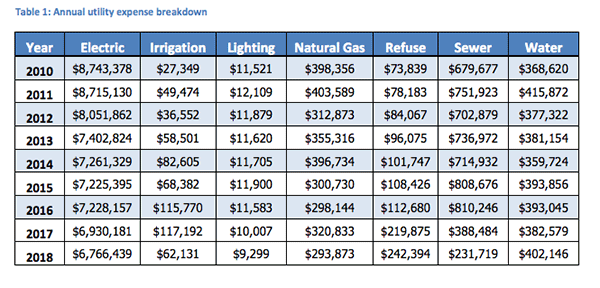
To cope with limited resources, OCFM leadership, in conjunction with the Orange County Board of County Commissioners (BCC), conceived a plan to reduce expenditures that would have a positive impact on the employees and customers of OCFM. The plan focused on reducing utilities expenditures for all the buildings. This plan led OCFM to reduce total utilities expenditures by 15 percent and electricity usage by 25 percent over the past eight years, totaling millions of dollars less in consumption.
Although the approach taken by OCFM was financially motivated, it was executed with sustainability in mind. Sustainability has many aspects. Therefore, OCFM in an effort to become more sustainable undertook a task that needed to be attacked on multiple fronts. After researching older methods and the range of responsibilities delegated to the division, OCFM decided to take an approach which addressed sustainability issues on four fronts: APPA Sustainability 2 1. Energy Consumption 2. Water Consumption 3. Solid Waste Usage & Disposal 4. Operations Energy consumption was the foremost issue in becoming more sustainable because it accounts for over 82 percent of utility expenditure for Orange County facilities over the past 10 years.
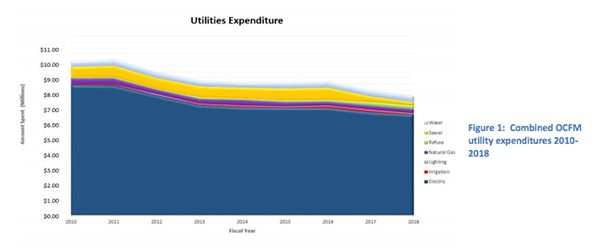
With over 400 buildings, the energy demand for Orange County facilities was very high. Working collectively with the BCC, administrative regulations were established to help control exuberant use of energy. The administrative regulations covered a wide variety of office-related energy use such as: limiting appliances to designated break rooms, automatically shutting down computers from 8 p.m. to 6 a.m., mandating Energy Star rated purchases when available, requiring vending machines to have energy saving devices, using ASHRAE temperature standards for HVAC, and limiting areas with heated water access. These regulations paved the way for changing the energy consumption culture throughout the county.
Independently, OCFM has mitigated energy consumption by changing lighting fixtures to LED lights with motion sensors and dimmers and using a building automation system to regulate temperature and lighting. Crucial to improving energy conservation, a minimum of two facilities each month undergo an energy audit to investigate how and how much energy is used and where improvements can be made in energy conservation.
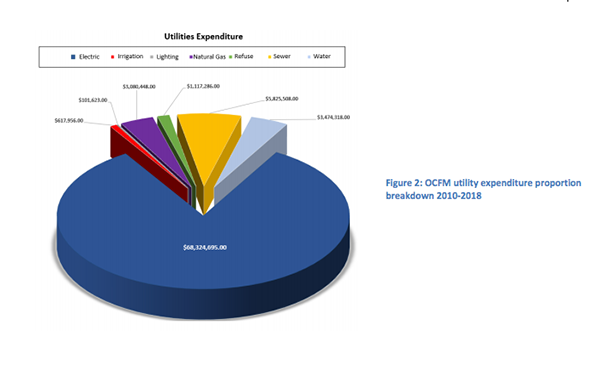
While simple changes can easily influence energy consumption, reducing water consumption proved more difficult. Irrigation accounts for a large portion of water use for Orange County facilities. All irrigation systems on county property were equipped with rain sensors to prevent wasteful landscape irrigation. The irrigation systems have also been converted to reclaimed water systems. The irrigation schedule is seasonally altered to abide by the local water authority frequency guidelines. In all renovations, low-flow toilet fixtures are included in specifications and as required by local AHJ.
While OCFM has more control over water and energy usage, solid-waste generation was much more difficult to mitigate. To reduce solid waste, recycling containers have been placed in offices, break rooms, work and public areas throughout the buildings. The widespread availability of recycling containers helps provoke facility occupants to be more conscious of recycling when they discard items. Maintenance work orders are generated through a CMMS and sent to iPads to eliminate the need to print work requests. Employees now use more smart devices to read and review documents rather than the traditional printed copies.
The most crucial part of OCFM’s move towards sustainability is the alteration in operations. Implementing a Think Green culture has stimulated the entire division to be aware of their impact on the environment. This culture inspired the office of environmental protection to dedicate staff to prevent energy waste and promote sustainable practices. Each department/division within the county assigns conservation coordinators to be liaisons between the facility occupants and OCFM. Walkarounds are routinely conducted by these coordinators to spot any potentially wasteful practice or system.
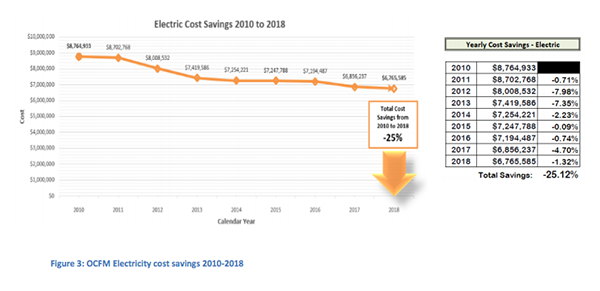
The greatest hurdle faced throughout this undertaking was the large scope of work. With over 400 buildings, thousands of fixtures needed converting to more sustainable alternatives. The initial investment required was substantial. However the future savings made the task worthwhile. Taking APPA Sustainability 3 advantage of rebates and incentives has greatly promoted the sustainability initiative by offsetting many costs, with over 190 projects funded through these resources.
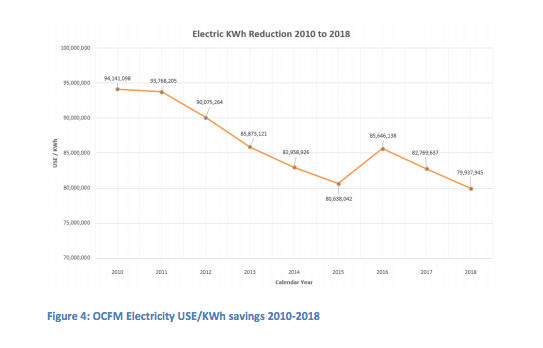
OCFM is dedicated to continuing sustainability by setting both short and long term goals. In 2015, management established goals of reducing both water and energy use 25 percent by 2020 and 50 percent by 2040. Targets were set at reductions of 4-6 percent annually. At the current pace, OCFM is set to exceed the established goals and become a role model for the community in the field of sustainability. While there is no single point solution to sustainability and resource preservation, Orange County government is now, and continues to, work diligently towards measures to conserve natural resources, reduce the carbon footprint and implement sustainable practices to protect the environment for our present and future generations.
↑ Back to top













